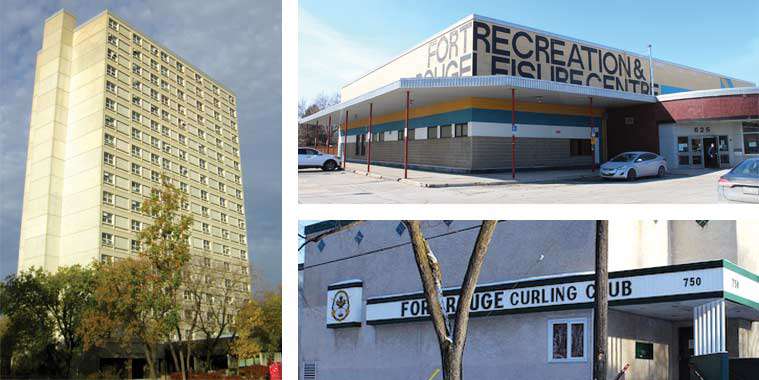The Winnipeg Electric Railway Company (WERCo), the private entity that operated the city’s streetcar system, owned twelve acres of land west of Osborne Street between Morley and Walker Avenues. From 1904 to 1954, it was home to the south end “car barns”, a depot for streetcars when not in service, and a manufacturing shop where around 230 of Winnipeg’s streetcars were built.
Two years after the Greater Winnipeg Transit Commission, forerunner to Winnipeg Transit, took over the assets of the company in 1953, it pulled the streetcars out of service. The land was then sold off and its redevelopment brought great changes to the Lord Roberts neighbourhood.
Fort Rouge Curling Club (1959)
750 Daly Street S.
The Fort Rouge Curling Club opened its first rink on December 10, 1919, on land provided by the WERCo near Osborne and Kylemore.
The Club’s president during its formative years was Sydney Campbell. He was a well-known figure in the community, having served as principal of Lord Roberts School from its opening in 1911 until his retirement in 1943.
The Club’s mens, womens and junior teams enjoyed success throughout the early decades. This peaked in the 1950s when the Fort Rouge team, skipped by Bill Walsh, won the Brier in 1952 and 1956.
Just weeks after the second brier win, the Winnipeg Transit Commission informed the Club that the land on which their rink stood had been sold to Loblaws Groceteria Company.
An anonymous source told the Free Press at the time that Loblaws, which had bought about seven acres of the WERCo land, offered the Club a new lot just a block away on Daly Street near Morley Avenue for an undisclosed sum. The Club purchased the land and spent the next couple of years selling debentures to fund the construction of their new home.
The Club played its 1958-59 season at the Granite Curling Club, and construction began the following spring on the new $130,000, six-sheet Fort Garry Curling Club. It opened on December 5, 1959, with Premier Duff Roblin cutting the ribbon, and area councillor Charles Avery throwing the first rock.
Fort Rouge Recreation and Leisure Centre (1958, 1977)
625 Osborne Street
Ontario-based grocery giant Loblaws Groceteria Co. entered the Winnipeg market in a big way by opening six stores between July 1958 and April 1959. The 625 Osborne Street location opened on December 2, 1958.
The Loblaws chain was facing financial ruin in the early 1970s and had to slash its operations across the country. This store was closed in 1974 and the Loblaws name disappeared altogether from Winnipeg’s retail landscape by the end of 1980.
Initially, the province’s Manitoba Housing and Renewal Corporation purchased the store and some adjacent land on which to build subsidized housing. There was an outcry from area residents who said that additional housing needed to be offset by more recreation space.
The area community committee agreed, and, upon request, the province sold the property to the city for the $600,000 it had paid for it.
Work got underway in 1977 to transform the 25,000 square foot space into a recreation centre that includes a gymnasium, auditorium, and numerous multi-purpose spaces for exercise, art classes, and seniors programming. The cost of the renovations was around $500,000.
The Fort Rouge Recreation and Leisure Centre was officially opened on October 15, 1977. After the ceremony, dignitaries went behind the building to participate in the sod turning for the Sam Southern Arena which opened the following year. The Osborne branch of the Winnipeg Public Library was added in 1982.
Fred Tipping Place (1974)
601 Osborne Street
The Ed Schreyer provincial government of the 1970s was on a mission to construct thousands of new, affordable housing units across Manitoba through the Manitoba Housing and Renewal Corporation.
The first Lord Roberts project was the 18-storey Fred Tipping Place, a rental block for moderate income seniors. It was designed by Moody Moore Architects, whose other projects around that time included the Medical Arts Building, St. Stephens Broadway United Church, and Lockhart Hall at the University of Winnipeg
Constructed in 1973-74, the $2.3 million block contains 205 suites, all one bedroom or bachelors, with common exercise room, lounge area and commercial kitchen. It was officially opened on April 30, 1974.
The building is named after labour leader Fred Tipping who was a Strike Committee member during the Winnipeg General Strike. A teacher by trade, he taught at Lord Roberts School for over 40 years. He was also a founding member of the Lord Roberts Community Club and the Manitoba Teachers Society.
Tipping died in 1973 while the building was under construction.
This was not Manitoba Housing and Renewal Corporation’s only subsidized housing project on former WERCo land. Between 1975 and 1977, it financed the construction of Nassau Square, a 95-townhouse development designed by Gustavo da Roza who is best remembered for his design of the Winnipeg Art Gallery.
Christian writes about local history at his blog, West End Dumplings.



